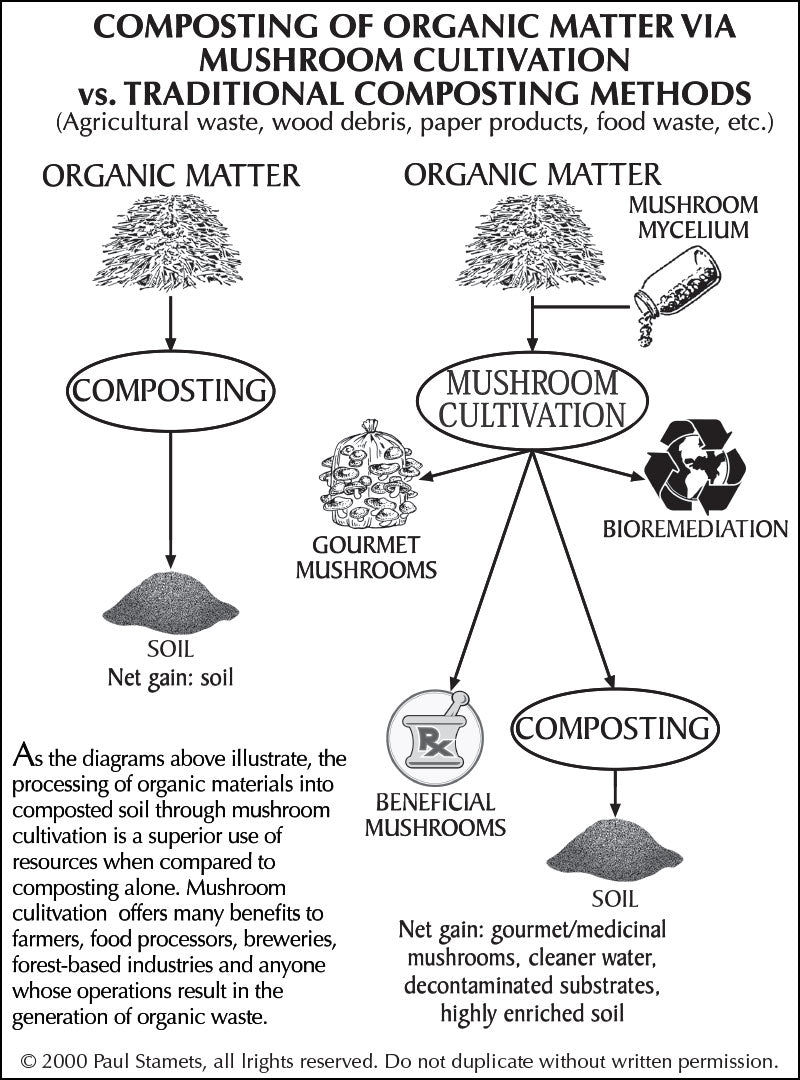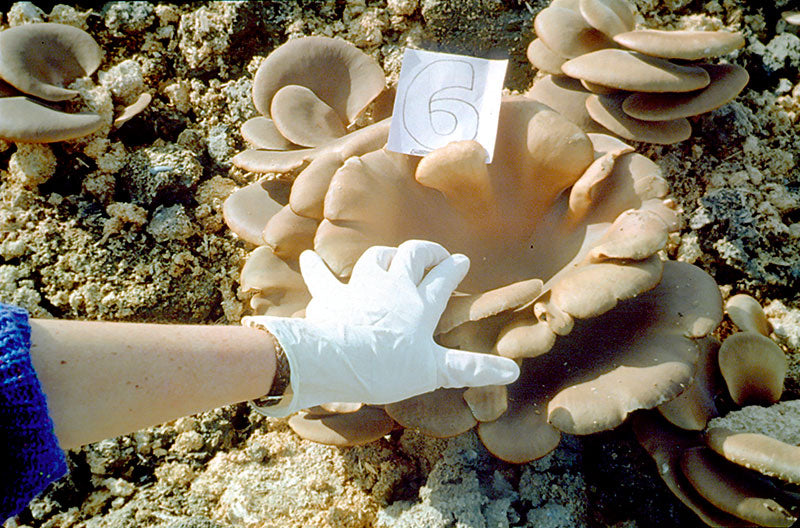
Helping the Ecosystem through Mushroom Cultivation
Adapted from the article, "Earth's Natural Internet" by Paul Stamets,
published in the Fall 1999 issue of Whole Earth Magazine
Mushroom growing isn't just a rapidly expanding agribusiness; it's also a significant tool for the restoration, replenishment and remediation of Earth's overburdened ecosphere. Like most people, we at Fungi Perfecti are concerned about the depletion of resources, loss of habitat and release of toxic substances into the environment. We'd like to show you some of the many ways in which the cultivation of mushrooms can help to tip the scales in Nature's favor, thereby benefiting all the inhabitants of Planet Earth.
Farmers, gardeners and scientists have long known about the importance of healthy soil. Human populations have ebbed and flowed according to the carrying capacities of their environment and the food chain it provides. But despite our long history with our environment, we know surprisingly little about the ground beneath our feet. And yet, it is the very soil upon which we depend that is in dire jeopardy. Unless we begin to understand and utilize the dynamics of soil creation, the matrix of life on this planet may begin to unravel. Genetic diversity and resilience could suffer to the point of mass extinctions, the scope of which could be comparable to the cataclysms of 60 million years ago. These extinctions appear to be underway—we are noticing only the more obvious victims.
Covering most all landmasses on the planet are huge masses of fine filaments of living cells from a kingdom barely explored. More than 8 miles of these cells, called mycelia, can permeate a cubic inch of soil. Fungal mats are now known as the largest biological entities on the planet, with some individuals covering more than 20,000 acres. Growing outwards at one quarter to two inches per day, the momentum of mycelial mass from a single mushroom species staggers the imagination. These silent mycelial tsunamis affect all biological systems upon which they are dependent. As they mature and die back, panoply of other fungi quickly come into play. Every ounce of soil does not host just one species, but literally thousands of species of fungi. Of the estimated 1–2 million species of fungi—about 150,000 species being mushrooms—we have catalogued only about 50,000, of which 14,000 have been identified with a species name. The genetic diversity of fungi is vast by design, and apparently crucial for life to continue.
Waves of mycelial networks intersect and permeate through one another. This interspersing of mycelial colonies is the foundation of soils worldwide. Although seemingly undifferentiated under the microscope, the ability of fungi to respond to natural disasters and sudden changes in the environment are a testimonial to their inherent intelligence. I believe that mycelia are Earth's natural Internet, the essential wiring of the Gaian consciousness. The recent creation of the computer Internet is merely an extension of a successful biological model that has evolved on this planet for billions of years. The timing of the computer Internet should not be construed as a happenstance occurrence. Sharing intelligence might be the only way to save an endangered ecosystem. The planet is calling out to us. Will we listen in time? The lessons are around us. Will we learn?
The vast, interconnected mantle of mycelia reacts quickly to the availability of plant and animal debris, recycling carbon, nitrogen, sulfur, iron and other essential elements. When storms, floods, volcanoes, or other natural disasters wreak havoc on the environment, fungal champions come to the rescue, capturing debris with mycelium and beginning to recycle. Humans have the unfortunate distinction of creating more debris than any other organism on this planet. We have become the new natural disaster. From our minor significance in the biological world only 10,000 years ago, our population is now over 6 billion, continuing to rapidly increase, taxing resources and stressing habitats beyond their maxima.
Growing Mushrooms = Creating Fertile Soils
Saprophytic and parasitic fungi help create the organic components of topsoil, in alliance with myriad numbers of bacteria, insects, and other organisms. An orchestra of primary, secondary, and tertiary saprophytic fungi render wood into biodynamic soil components. These soils benefit plants that in turn use photosynthesis to manufacture their own foods.

Fresh hardwood sawdust and wood chips

Sawdust/wood chips colonized with mushroom mycelium
 Rich soil from composted Shiitake block refuse
Rich soil from composted Shiitake block refuse
Fungi can selectively raise or lower soil pH, increasing the usability of existing soils without the need for additional adjustment prior to use.
|
Comparison of Nutritive Content Between Commercial Soil
Analysis provided by University of Idaho Holm Research Center, Moscow, ID |
In the course of breaking down forest and agriculture wastes, a directed biological succession begins. Composting without generating mushrooms is a lost opportunity for production of food and other valuable products and services.
Nearly all plants have joined with saprophytic and mycorrhizal fungi in symbiosis. Mycorrhizal fungi surround and penetrate the roots of grasses, shrubs and trees, expanding the absorption zone by 10 to 100 fold, aiding in their quest for water and increasing the moisture-holding capacity of soils. This close alliance also forestalls blights and is essential for longevity of the forest ecosystem. Throughout the life span of a Douglas Fir tree, nearly 200 species of mycorrhizal mushrooms can be joined in this most holy of alliances. The interrelationships of these species with other organisms in the forest are just beginning to be understood. What we do know is that fungal complexity is the common denominator of a healthy forest.
Unfortunately, the nearly 50% loss of mycorrhizal mushroom species in Europe forebodes of impending ecological collapse. With the loss of fungi, disease vectors soon plague the forest. The diversity of insects, birds, flowering plants and indeed all mammals begin to suffer. Humidity drops, now exposed soils are blown away, and deserts encroach, stressing resources all the while human populations artificially expand beyond the carrying capacity of their resident ecosystems.
Los Angeles, Mexico City, Bangkok and most cities are biological anomalies: they exist only from the subsidies of resources being from drawn from afar. Yet, much could be done with the massive importation of raw material into urban environments. Instead most of the imported materials eventually are diverted into toxic landfills, returning virtually nothing to the carbon bank from which they were drawn. Ever hear of a landfill selling their soil to gardeners? The current practice of garbage dumps is an ecological travesty. Good soil components are mixed in with plastics, heavy metals and chemical poisons.

The most progressive communities encourage composting of their refuse, a good first step, but this is far short of the potential that could be realized by making the public mycologically astute. Hope lies in making a concerted effort to aid the fungi in their natural role. "Where to begin?" is simpler to answer than trying to comprehend the enormity of the task at hand. Simply employ the skills of fungi and join with them in healing the scars of the planet. Not an ethereal task, any kindergarten student can make a significant contribution with the simplest guidance.
The potential benefits from employing fungi are enormous, and can be realized immediately. First, everyone is involved in spreading fungi. With airplane travel, international mail and trade, spores of fungi have hitchhiked across the planet. This re-mixing of the fungal genome may be a fortuitous event. Nature needs to create a new equilibrium. The human factor is the uncertain variable. The first step in helping Nature is to consciously use fungi, mushrooms in particular, in recycling and in the generation of foods. This elementary step was first industrialized by the mushroom growing industry. Little did the first mushroom cultivators realize that they had taken a revolutionary step in harnessing one of the most powerful biological forces of nature.
Mycoremediation
From a piece of tissue the size of one tenth of your little fingernail, what we call a clone, cells can be grown exponentially into millions of pounds of mushrooms in as little as several months. More than 10% of the growing medium or "substrate" (straw, sawdust, compost, most agricultural and forest debris) can be converted into a protein- and vitamin-rich food. Not only are these mushrooms nutritious, they have demonstrated abilities in enhancing the human immune system, and they produce a slew of natural antibiotics. Yet it is the residual mycelium in that substrate that holds the greatest potential for ecological rehabilitation.
Mycelia can serve as unparalleled biological filters. When I first moved to my property, I installed an outdoor mushroom bed in a gulch leading to a saltwater beach where clams and oysters were being commercially cultivated. An inspection showed that the outflow of water from my property was jeopardizing the quality of my neighbor's shellfish with the bacteria count close to the legal limit. The following year, after the mushroom beds were colonized with mycelium, the coliform count had decreased to nearly undetectable levels. This led to the term I have coined "mycofiltration", the use of fungal mats as biological filters.
Mycelium produces extracellular enzymes and acids that break down recalcitrant molecules such as lignin and cellulose, the two primary components of woody plants. Lignin peroxidases dismantle the long chains of hydrogen and carbon, converting wood into simpler forms, on the path to decomposition. By circumstance, these same enzymes are superb at breaking apart hydrocarbons, the base structure common to oils, petroleum products, pesticides, PCBs, and many other pollutants.
For the past four years I have been working with Battelle Laboratories, a non-profit foundation, whose mission is to use science to improve environmental health. Battelle is a major player in the bioremediation industry, and widely used by the United States and other governments in finding solutions to toxic wastes. The marine science laboratory of Battelle, Sequim, Washington became interested, as their mandate is to improve the health of the marine ecosystem. Under the stewardship of Dr. Jack Word, we began a series of experiments employing the strains from my mushroom gene library, many of which were secured through collecting specimens while hiking in the old growth forests of the Olympic and Cascade mountains. We now have applied for a patent utilizing mycelial mats for bioremediation, a process we have termed "mycoremediation".
After several years, and redundant experiments to prove to naysayers that our data was valid, we have made some astonishing discoveries. (I am continually bemused that humans "discover" what nature has known all along.) The first significant study showed that a strain of Oyster mushrooms could break down heavy oil. A trial project at a vehicle storage center controlled by the Washington State Dept. of Transportation (WSDOT) enlisted the techniques from several, competing bioremediation groups. The soil was blackened with oil and reeked of aromatic hydrocarbons. We inoculated one berm of soil approximately 8 feet x 30 feet x 3 feet high with mushroom spawn while other technicians employed a variety of methods, ranging from bacteria to chemical agents. After 4 weeks, the tarps were pulled back from each test pile. The first piles employing the other techniques were unremarkable. Then the tarp was pulled from our pile, and gasps of astonishment and laughter welled up from the observers. The hydrocarbon-laden pile was bursting with mushrooms! Oyster mushrooms up to 12 inches in diameter had formed across the pile. Analyses showed that more than 95% of many of the PAH (polycyclic aromatic hydrocarbons) were destroyed, reduced to non-toxic components, and the mushrooms were also free of any petroleum products.


After 8 weeks, the mushrooms had rotted away, and then came another startling revelation. As the mushrooms rotted, flies were attracted. (Sciarid, Phorid and other "fungus gnats" commonly seek out mushrooms, engorged themselves with spores, and spread the spores to other habitats). The flies became a magnet for other insects, which in turn brought in birds. Apparently the birds brought in seeds. Soon ours was an oasis, the only pile teeming with life! We think we have found what is called a "keystone" organism, one that facilitates, cascade of other biological processes that contribute to habitat remediation. Critics, who were in favor of using plants (as in "phytoremediation") and/or bacteria, reluctantly became de facto advocates of our process since the mushrooms opened the door for this natural sequencing.
In this series of experiments, our group made two other significant discoveries. One involved a mushroom from the old growth forest that produced an army of crystalline entities advancing in front of the growing mycelium, disintegrating when they encountered E. coli, sending a chemical signal back to the mother mycelium that, in turn, generated what appears to be a customized macro-crystal which attracted the motile bacteria by the thousands, summarily stunning them. The advancing mycelium then consumed the E. coli, effectively eliminating them from the environment. The other discovery, which I am not fully privy to, involves the use of one of my strains in the destruction of biological and chemical warfare agents. The research is currently classified by the Defense department as one mushroom species has been found to break down VX, the potent nerve gas agent Saddam Hussein was accused of loading into warheads of missiles during the Gulf War. This discovery is significant, as VX is very difficult to destroy. Our fungus did so in a surprising manner.
We believe that buffer zones around streams work primarily because of the mycelium resident in the first few inches of soil. Buffers with multi-canopied trees and shrubs combined with grasses, and the debris fall-out they provide, afford a mycologically rich zone, filtering out run-off from adjacent farms, highways and suburban zones. The mycologically rich riparian zones are cooler, attract insects which lay larvae (grub for fish), and then foster bird-life. Once the riparian zones achieve a plateau of complexity, they become self-sustaining. Amazingly, I have not heard of a single researcher ever mention the primary role fungi play in riparian buffers, let alone the purposeful introduction of mycelial colonies to protect watersheds. This method is ingeniously simple in its design and yet seemingly out of grasp of politicians. The prejudice against mushrooms is a form of biological racism—mushrooms are just not taken seriously.
Mycofiltration is a natural fit to John Todd's "Living Machine®" use of estuary ecosystems to break down toxic wastes. The marriage of upland use of mushroom mycelium with estuary environments could solve—in the short term—some of the greatest challenges threatening our ecosystem, and truly give meaning to the word "sustainability". We are currently moving towards unifying these two friendly technologies in the creation of a new paradigm for the 21st century. However, we need help.
Conclusions
What our team has discovered given our elementary research is that the fungal genome has far greater potential in treating a wide variety of environmental and health concerns than we could have conceived. Although we have looked at just a few of the mushroom species resident in the Old Growth, clearly these ancestral strains of mushrooms have survived millennia due to their inherent ability to adapt. These adaptive mechanisms are the very foundation of ecological stability and vitality in an increasingly more rapidly changing environment. Mushrooms are "smart" fungi. These discoveries coming to me are perhaps no accident. Your reading this article is perhaps no accident. Regardless, let's take advantage of a unique coincidence to empower individuals, communities and vast ecologies by harnessing the power of mushroom mycelium.
What can you do? Delineate your garbage into categories. Not only compost all organic debris, but segregate the refuse into piles appropriate for a variety of desired mushroom species. Inoculate cardboard and paper products, coffee grounds, and wood debris with mushroom spawn. Teach children about the role of fungi, especially mushrooms, in the forests and their critical role in building soils. Encourage mushrooms to grow in your yards by mulching around plants. Take advantage of catastrophia—natural disasters are perfect opportunities for community-action recycling projects. We should learn from our elders. Native peoples worldwide have viewed fungi as spiritual allies. They are not only the guardians of the forest. They are the guardians of our future.
Fungi Perfecti has the strains, the knowledge and the facility for projecting mycelium en masse. We are very familiar with acclimating mycelium to outdoor environments. Those interested in applying these technologies are invited to contract with us for our services. Serious inquiries only, please.
Related Links
The foundations for many of the cultivation techniques described in this document are detailed in Paul's essential textbooks, Growing Gourmet and Medicinal Mushrooms and The Mushroom Cultivator.
The Centers for Disease Control and Prevention's National Report on Human Exposure to Environmental Chemicals offers much food for thought on the subject of environmental contamination.
The PBS documentary "Trade Secrets: A Moyers Report" is a detailed and chilling account of the chemical industry's efforts to conceal the harmful effects of vinyl chloride, benzene and other toxic chemicals on their own employees, the greater public and the environment.
